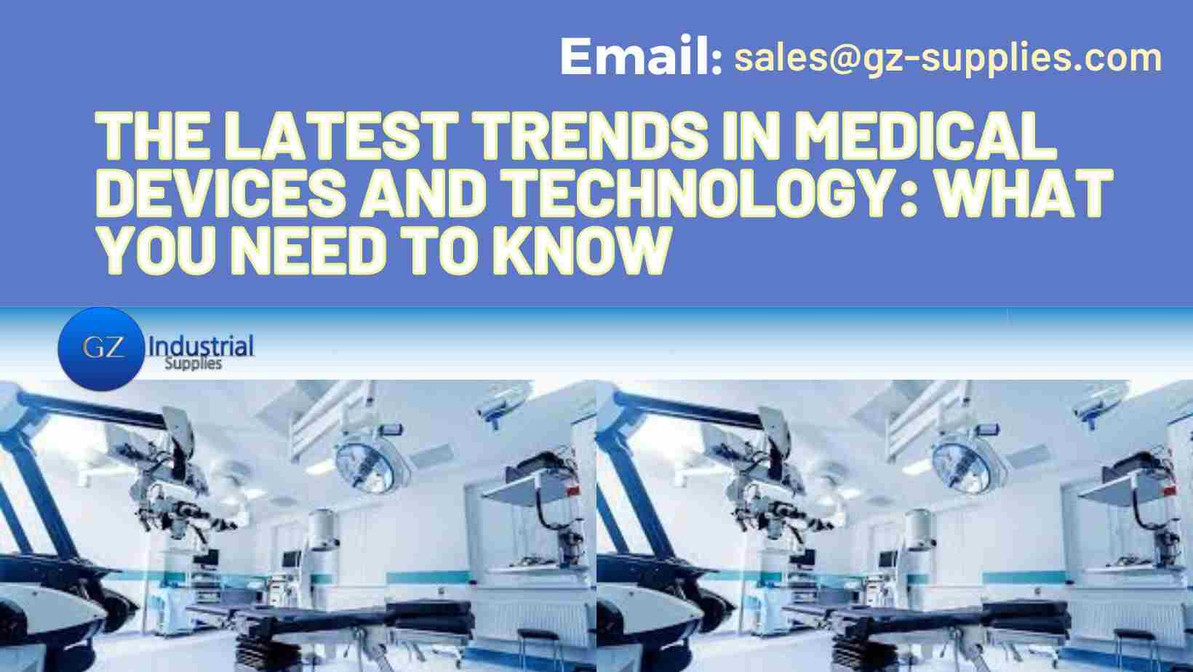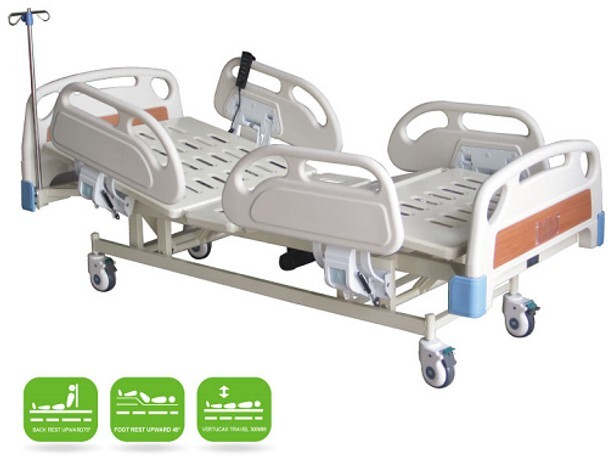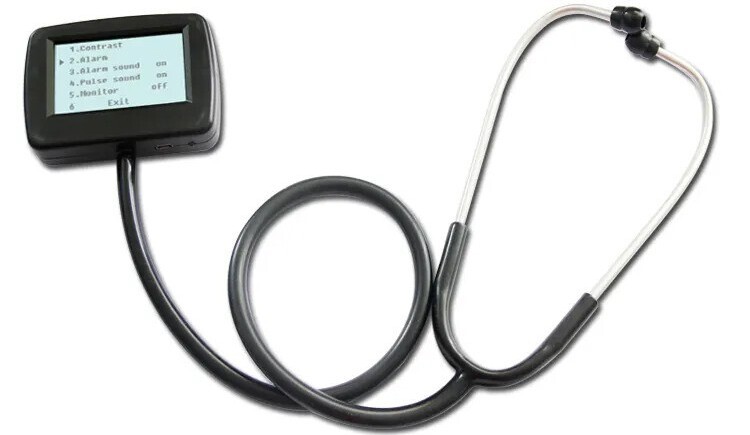The Latest Trends in Medical Devices and Technology: What You Need to Know
In today's rapidly evolving healthcare landscape, the intersection of medical devices and technology is transforming the way we diagnose, treat, and manage various medical conditions. Medical devices encompass a wide range of instruments, equipment, implants, and diagnostic tools used in healthcare settings to diagnose, treat, monitor, and prevent diseases and medical conditions. These devices range from simple tools like thermometers and blood pressure monitors to advanced technologies such as MRI machines and robotic surgical systems.
Tektronix TBS2104B Digital Storage Oscilloscope
One of the key trends in patient monitors is the integration of wireless connectivity features. Modern patient monitors can seamlessly connect to hospital networks or cloud-based platforms, enabling real-time transmission of patient data to healthcare providers' devices such as smartphones, tablets, or computers. This wireless connectivity enhances communication and facilitates remote monitoring, allowing healthcare teams to access critical patient information anytime, anywhere. Technology plays a crucial role in enhancing the capabilities and functionalities of medical devices. These innovations aim to improve patient outcomes, enhance healthcare delivery, and revolutionize the practice of medicine.
Staying updated on the latest trends in medical devices and technology is essential for healthcare professionals, researchers, policymakers, and industry stakeholders for several reasons and this content provides an overview of the dynamic field of medical devices and technology, emphasizing the importance of staying updated on the latest trends.
Emerging Trends in Medical Devices
In recent years, the landscape of medical devices has undergone a transformative evolution, marked by innovative breakthroughs that enhance patient care and redefine healthcare practices. Here are some key emerging trends in various medical devices:
1. Patient Monitors:
The latest patient monitors are embracing remote monitoring trends, allowing healthcare providers to track patient vitals in real-time, even from a distance. This technology has been particularly useful during the pandemic, as it minimizes contact and allows for continuous patient observation. In addition to that, patient monitors are now equipped with sophisticated data analytics capabilities. Machine learning algorithms analyze continuous streams of patient data, providing healthcare professionals with valuable insights and early warnings, leading to proactive intervention and improved patient outcomes. Also, advancements in sensor technologies have led to the development of non-invasive monitoring techniques. Wearable and contactless sensors provide accurate data without the discomfort associated with traditional monitoring methods, promoting patient compliance and comfort.
2. Medical Beds:
Smart medical beds are revolutionizing patient-care environments. These beds are now integrated with technology that can monitor patient vitals, adjust positioning to improve comfort, prevent bedsores and even alert medical staff if a patient attempts to get up, reducing the risk of falls. This evolved design of medical beds prioritises patient comfort and safety. Adjustable features, such as incline, height, and pressure redistribution, cater to individual patient needs, promoting better rest and faster recovery.
Electric Hospital Bed 230kg ARI MEDICALS
3. Oxygen Concentrators:
Advancements in oxygen concentrators have made them more portable and efficient, with improved user-friendly features. These devices are crucial for patients with respiratory conditions, providing a consistent supply of oxygen without the need for bulky tanks. The latest trend in oxygen concentrators focuses on portability and wearability. Compact, lightweight devices allow patients to maintain their mobility while receiving the necessary oxygen therapy. Wearable options further enhance convenience, enabling patients to seamlessly integrate therapy into their daily lives. In addition to that, modern oxygen concentrators prioritize energy efficiency, contributing to sustainability initiatives in healthcare. These devices utilize advanced technologies to deliver oxygen therapy while minimizing power consumption, reducing environmental impact.
4. Defibrillators:
The development of extravascular defibrillators is a significant innovation. These devices deliver life-saving defibrillation therapy with leads placed outside of the heart and veins, reducing the risk of long-term complications associated with traditional, transvenous ICDs. Also, Automated External Defibrillators (AEDs), have become more accessible and user-friendly, making them vital in emergency situations outside of traditional healthcare settings. Integration with smart technologies provides step-by-step guidance to bystanders, increasing the chances of successful defibrillation before professional help arrives.
Cardiac Monitor And Defibrillator
5. Ultrasound:
Ultrasound technology has seen improvements in high-contrast resolution, high-fidelity transmission, and one-touch image optimization. These advancements contribute to better diagnostic capabilities and improved patient outcomes. Advancements in this space have also led to the development of handheld and portable devices, providing flexibility in various healthcare settings. These compact tools offer real-time imaging, facilitating quicker diagnostic assessments and enhancing point-of-care applications. Artificial intelligence is increasingly integrated into ultrasound systems, assisting healthcare professionals in image interpretation. AI algorithms can identify patterns and anomalies, supporting more accurate diagnostics and reducing the reliance on extensive training for interpretation.
Ultrasound CMS600S-VET B- Contec
6. Dialysis Machines:
Dialysis machines have been improved with new systems that enhance the treatment process. Innovations include better flow control, more efficient filtration, and enhanced ultrafiltration control systems, leading to improved patient care. Emerging trends in dialysis machines focus on providing options for home-based treatments. Compact and user-friendly devices empower patients to manage their dialysis routines in the comfort of their homes, improving overall quality of life.They also now offer continuous monitoring capabilities, allowing healthcare providers to remotely track treatment parameters. This ensures timely intervention in case of any deviations from the prescribed treatment plan, fostering a proactive approach to patient care.
Electrical dialysis chair with wheels
7. Suction Machines:
Modern suction machines have become more compact and portable, with advancements such as battery-powered operation and noise reduction technology. Adjustable suction levels and digital displays enhance user control and patient safety. Advanced suction machines now also offer customizable settings to cater to diverse medical scenarios. Variable suction levels ensure precise control, adapting to the specific needs of different patients and medical procedures.
Suction Machine With Catheters
8. Operating Lights:
Operating lights have transitioned to LED technology, providing bright, focused illumination during surgical procedures. LED lights offer improved color rendering and temperature control, reducing eye strain for surgeons, enhancing visibility in the operating room and reducing heat generation. Besides that, emerging operating lights are equipped with adjustable features, allowing surgeons to control light intensity and direct illumination precisely where needed. This adaptability ensures optimal visibility and promotes precision during surgery.
AML04L.III (Stand Type) Aperture Series Operating Lamp
9. Operating Tables:
Innovations in operating tables include motorized adjustments, imaging compatibility, and ergonomic designs that enhance precision and efficiency in surgical procedures. Modern operating tables are designed with versatility and patient comfort in mind. These tables offer multiple positioning options, enabling surgeons to customize the table's configuration for various procedures. Ergonomic designs enhance the overall efficiency of the operating room.
JY.D Universal Operating Table
10 Stethoscopes:
Stethoscope advancements have transformed their use in chest auscultation. Digital stethoscopes now feature Bluetooth connectivity, advanced auscultation amplification, background noise cancellation, and tunable chest pieces for high-end precision. Some modern stethoscopes integrate artificial intelligence algorithms for auscultation analysis. These algorithms can assist in identifying subtle acoustic cues, contributing to more accurate diagnoses and reducing the reliance on the listener's expertise alone.
CONTEC CMS-M Electronic Multifunctional Visual Stethoscope with SPO2 probe, Heart Rate
Advancements in Medical Technology
The relentless pursuit of innovation in medical technology has ushered in a new era of capabilities, offering unprecedented precision, customization, and efficiency. Here are the key advancements shaping the landscape:
- Robotic Surgery:
Robotic surgery has seen significant advancements, with innovations leading to improved precision and accuracy.
- Precision and Minimally Invasive Procedures: Modern robotic surgical systems are equipped with highly dexterous arms and miniaturized instruments that reduce tremors and enable delicate maneuvers. The integration of imaging and visualization technologies, along with haptic feedback systems, allows surgeons to operate with enhanced precision and safety. Allowing for minimally invasive procedures with smaller incisions, reduced scarring, and quicker recovery times.
- Telepresence and Remote Surgery: Teleoperation capabilities have also expanded the reach of specialized healthcare, enabling surgeries to be performed remotely. This is especially valuable for accessing expertise in underserved areas and providing timely interventions in emergency situations. The use of artificial intelligence (AI) and machine learning (ML) in robotic surgery aids in surgical decision-making and improves the recognition of complex anatomical structures.
- 3D Printing in Medicine:
3D printing is revolutionizing medicine by enabling the creation of patient-specific implants and prosthetics, as well as anatomical models for surgical planning. The technology allows for
- Customized Implants and Prosthetics: 3D printing has transformed the production of medical implants and prosthetics by enabling personalized, patient-specific designs. This customization ensures a better fit, improved functionality, and enhanced comfort for individuals receiving these devices.
- Bioprinting for Tissue and Organ Fabrication: One of the most groundbreaking applications of 3D printing in medicine is bioprinting. Researchers are exploring the possibility of printing functional tissues and even entire organs using a patient's own cells. This holds immense potential for organ transplants, reducing the reliance on donor organs.
- Nanotechnology in Healthcare:
Nanotechnology is transforming healthcare by enabling the development of smart pills, nanobots for micro-scale surgeries, and nanofibers for tissue engineering. It offers new possibilities in
- Precision Medicine and Targeted Therapies: Nanotechnology is contributing to the development of precision medicine by enabling targeted drug delivery. Nanoparticles can be engineered to deliver medications directly to specific cells or tissues, minimizing side effects and enhancing treatment efficacy.
- Diagnostic Nanosensors for Early Disease Detection: Nanoscale sensors are being employed for early detection of diseases. These highly sensitive devices can identify biomarkers and abnormalities at the molecular level, enabling early intervention and significantly improving the prognosis for various conditions.
Medical and Hazardous waste incinerator
Eye Devices and Treatment: Advancements in Vision Care
The field of ophthalmology has seen groundbreaking advancements in medical technology, revolutionizing the way eye conditions are diagnosed and treated. From smart contact lenses to AI-powered diagnostics, the latest innovations in eye care aim to enhance vision, improve patient comfort, and provide more effective treatments for common and complex eye disorders.
- AI-Powered Eye Diagnostics
Artificial intelligence (AI) is transforming eye care by enabling faster and more accurate diagnoses. AI-powered retinal imaging and diagnostic tools can detect early signs of conditions like diabetic retinopathy, glaucoma, and macular degeneration with greater precision than traditional methods. These systems use deep learning algorithms to analyze high-resolution images of the eye, allowing ophthalmologists to diagnose diseases at an early stage, leading to timely interventions and better patient outcomes.
- Smart Contact Lenses
One of the most exciting innovations in eye devices is the development of smart contact lenses. These lenses are equipped with tiny sensors that can monitor eye health by measuring glucose levels in tears, tracking intraocular pressure for glaucoma patients, and even displaying augmented reality (AR) information. Some models also have built-in drug delivery systems, enabling precise and controlled medication release directly onto the eye, reducing the need for frequent eye drops.
- Advanced Cataract and LASIK Surgery Technologies
Laser-assisted cataract and LASIK surgeries have become more refined, offering patients improved vision correction with minimal recovery time. Femtosecond lasers are now widely used for bladeless procedures, increasing surgical precision and reducing risks. Intraocular lenses (IOLs) have also evolved, with multifocal and light-adjustable lenses providing clearer vision across different distances, significantly reducing dependence on glasses after cataract surgery.
- Wearable Assistive Devices for the Visually Impaired
Innovative wearable devices are enhancing the lives of visually impaired individuals by offering real-time assistance. AI-powered smart glasses can recognize text, identify objects, and even describe surroundings audibly, helping users navigate their environment with greater independence. Some advanced models use augmented reality to enhance contrast and magnify images, providing better visual aid for individuals with low vision.
- Blue Light Filtering and Digital Eye Strain Prevention
With the rise in digital screen usage, blue light exposure has become a significant concern. Modern eye care solutions now include blue light-blocking lenses and smart glasses that reduce strain and fatigue caused by prolonged screen time. Additionally, eye drops designed to combat digital eye strain and promote tear production are gaining popularity, providing relief for individuals who spend long hours on digital devices.
As technology continues to evolve, these advancements in eye devices and treatment options are improving vision care and making treatments more accessible and effective. Whether through AI-driven diagnostics, smart lenses, or laser-assisted procedures, the future of ophthalmology is brighter than ever.
Impact of Technology on Healthcare Delivery
Improved Patient Care and Outcomes:
The integration of health information technology (IT) into healthcare delivery has significantly improved patient care and outcomes.
- IT enables the systematic review of care delivery and patient outcomes, leading to the identification of problems and the implementation of solutions that enhance patient safety and quality of clinical care.
- Digital healthcare tools have been instrumental in reducing variations in care, preventing injury or harm, and minimizing diagnostic errors. They also improve treatment options and increase opportunities for quality of life improvements for both patients and healthcare providers.
Enhanced Efficiency in Healthcare Systems: Digital technologies have had a profound impact on the efficiency of healthcare delivery.
- They enable the protection of doctors and patients from unnecessary contact, especially in the context of infectious diseases.
- The digital transformation within healthcare systems has led to improved service delivery, better quality control, and reduced costs. Innovations such as the Internet of Things (IoT) and advanced analytics optimize clinic activities and enterprise business processes, while innovative expert systems assist in early disease diagnosis and treatment.
Challenges and Ethical Considerations: The widespread adoption of digital healthcare technology presents several ethical challenges. These include
- Ensuring fair and just applications to improve healthcare for all,
- Maintaining human value in the face of novel digital health devices and procedures,
- And addressing issues such as digital illiteracy, inequities in access to healthcare, informed consent, data dignity, fairness in storage, access, sharing, and ownership.
It is crucial for all stakeholders to shape digital health in an ethical and fair way, ensuring that digital health interventions are designed and set up to foster health equity for all population groups.
Conclusion
The landscape of medical devices and technology is rapidly evolving, driven by the relentless pursuit of innovation and the desire to enhance patient care. The emerging trends in medical devices are making healthcare more accessible, efficient, and effective, while advancements in medical technology are pushing the boundaries of what’s possible in medicine. The impact of these technologies on healthcare delivery is profound, offering improved patient outcomes and operational efficiencies, yet also presenting new challenges and ethical considerations.
As we look to the future, it is clear that technology will continue to play a pivotal role in shaping the healthcare industry. It is incumbent upon healthcare professionals, policymakers, and technologists to work collaboratively to harness these advancements responsibly, ensuring that they lead to equitable health outcomes and uphold the highest ethical standards. By doing so, we can ensure that the promise of modern medical technology is fully realized for the benefit of all. If you have any questions or enquiries, do well to Contact Us Today
Recent Posts
-
Why Use Distilled Water For Inverter Battery
Inverter batteries play a crucial role in ensuring the effective functioning of home and i …Apr 01, 2025 -
THE BEST MAGNETIC DRILLING MACHINE IN NIGERIA 2025 REVIEWS
Introduction The Magnetic drilling machines are power tools also called mag drills. They are es …Mar 31, 2025 -
Top Selling Magnetic Drilling Machines in Nigeria
Magnetic Drilling Machine is a portable drilling machine with a magnetic base (either electroma …Mar 31, 2025













